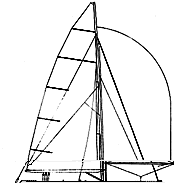UFO
One design racerr
If the competition was the most important element, we would all buy well-established one-designs like Snipes, Solings or J/24s. But there is a part of us that likes to shoot for the moon and find the boat that goes the fastest. We can only hope that our friends will come to the same conclusion and a class will be formed.
The UFO comes from the Italian design studio of Umberto Felci. Mr. Felci has had extensive experience designing race boats for the Lake Garda races. These races favor raw boat speed and are known for radical designs. It is an excellent proving ground for a young designer to test boat shapes.
With that in mind, it is no surprise that the 28-foot, 3-inch UFO is different from our current group of sport boats. The UFO has wings. No, not on its keel, on its deck. Using my trusty tick strip, I estimate that while beam on deck is 11 feet, 10 inches, the beam at the waterline is only 5 feet, 11 inches. The dramatic topsides flair that creates the wings provides a hiking platform for the crew of five. The boat is intended to be sailed flat, which keeps the leeward wings from dragging. These wing sections actually unbolt and remove for trailering. When you look at the profile of this design, you can see the rise to the wings aftÑthat's why the sheerline looks so strange and humped.
In profile the hull shows very little fore and aft rocker. The canoe body runs almost flat through the middle of the boat, kicking up at the bow and at the stern. The keel fin is a box steel section and composite fin supporting an 882-pound lead bulb. The keel is removable for trailering. The outboard rudder shows about 10-percent balance area. The D/L is 48.7, almost identical to that of an Open Class 50.
The rig looks a little on the squatty side but that's deceptive. The SA/D is 35.97 and the low-aspect-ratio mainsail will help keep the center of pressure low to minimize heeling. There is no standing backstay and the runners and checkstays are led to the quarters. I prefer to see runners led much closer to centerline to help keep the mast in column.
An interesting departure in this rig from other sport boats is the lack of a retracting carbon fiber jib boom. This boat is set up to carry a normal, symmetrical chute on a pole that exceeds the J dimension by 32 inches. I think that the asymmetrical chute craze may be more of a fad than solid thinking. Asymmetrical chutes have proven less than effective on a lot of boats, although the owners of those boats would prefer to spend their days reaching their way back and forth into ninth place rather than admit it. Oh well. If enjoying sailing is measured by miles sailed, they are having more fun. Mr. Felci has opted for a traditional spinnaker setup on his nontraditional boat.
Construction features PVC foam and biaxial fabrics laminated with epoxy resin, vacuum-bagged then baked in an oven to a golden brown for post-curing. There is a watertight engine compartment built into the cockpit sole for the outboard.
I like this design. All the photos show it moving well in a variety of wind conditions. I like the idea of wings to add turbo power to my own hiking efforts. The expansive deck gives plenty of elbow room for large crewmembers to move about. I think it could be fun to bring the first of these to town.

Comments